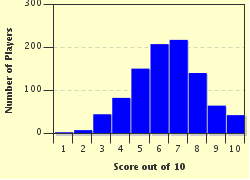Quiz Answer Key and Fun Facts
1. What is unusual about the cheeks of the golden hamster?
2. Most slugs have two pairs of feelers. The top ones are for sensing light. What do the lower ones do?
3. Which European country, the highest consumer of donkey meat, uses this product in several regional dishes?
4. Which cerebral feature of the koala is greatly reduced in size compared to that of its ancient ancestors?
5. Sheep have scent glands which are located in front of their eyes - and, astonishingly so, on which other part of their bodies?
6. What happens to the tail feathers of a rooster that has been castrated?
7. Regarding their human prey, what particular aspect of humanity acts as an odorous lure and appeals most to mosquitoes?
8. Old male giraffes are given which unflattering nickname?
9. According to the bible, which animal's hair was used to make curtains for the tent that contained the tabernacle?
10. Do Male monkeys go bald the same way that human men do?
Source: Author
Creedy
This quiz was reviewed by FunTrivia editor
crisw before going online.
Any errors found in FunTrivia content are routinely corrected through our feedback system.


